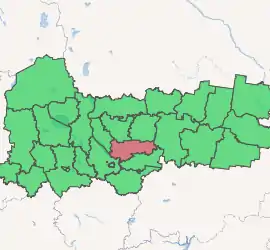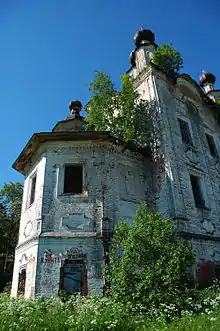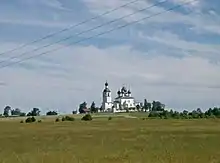Sokolsky District, Vologda Oblast
Sokolsky District (Russian: Со́кольский райо́н) is an administrative[1] and municipal[8] district (raion), one of the twenty-six in Vologda Oblast, Russia. It is located in the center of the oblast and borders with Kharovsky and Syamzhensky Districts in the north, Totemsky District in the east, Mezhdurechensky District in the south, Vologodsky District in the southeast, and with Ust-Kubinsky District in the northwest. The area of the district is 4,100 square kilometers (1,600 sq mi).[4] Its administrative center is the town of Sokol[3] (which is not administratively a part of the district).[1] Population: 12,947 (2010 Census);[5] 14,951 (2002 Census);[10] 17,585 (1989 Census).[11]
Sokolsky District
Сокольский район | |
|---|---|
.png.webp) Flag  Coat of arms | |

Location of Sokolsky District in Vologda Oblast | |
| Coordinates: 59°28′N 40°07′E | |
| Country | Russia |
| Federal subject | Vologda Oblast[1] |
| Established | July 15, 1929[2] |
| Administrative center | Sokol[3] |
| Area | |
| • Total | 4,100 km2 (1,600 sq mi) |
| Population | |
| • Total | 12,947 |
| • Estimate (2018)[6] | 48,563 (+275.1%) |
| • Density | 3.2/km2 (8.2/sq mi) |
| • Urban | 37.0% |
| • Rural | 63.0% |
| Administrative structure | |
| • Administrative divisions | 1 Towns of district significance, 12 Selsoviets |
| • Inhabited localities[7] | 1 Cities/towns, 406 Rural localities |
| Municipal structure | |
| • Municipally incorporated as | Sokolsky Municipal District[8] |
| • Municipal divisions[8] | 2 Urban settlements, 8 Rural settlements |
| Time zone | UTC+3 (MSK |
| OKTMO ID | 19638000 |
| Website | http://www.sokoladm.ru |
Geography
The district is elongated from west to east and lies in the basin of the Sukhona River. The westernmost part of the district is on the shore of Lake Kubenskoye. The source of the Sukhona is located in Ust-Kubinsky District, but a relatively short stretch of the river course runs through the district downstream of the source. In particular, the town of Sokol is located on the banks of the Sukhona. The rivers in the central and eastern parts of the district drain into the Dvinitsa River which crosses the district from north to south, as well as into other tributaries of the Sukhona such as the Pelshma, the Strelitsa, and the Tsaryova. The northwest of the district lies in the basin of the Kubena River which forms the border between Sokolsky and Ust-Kubensky Districts. The northeast of the district is in the basin of the Syamzhena River, a major tributary of the Kubena.
Considerable parts of the district are covered by forests.
History

The area was originally populated by the Finno-Ugric peoples and then colonized by the Novgorod Republic. In the 13th century, it became a part of the Principality of Beloozero. In the 14th century, the Principality of Beloozero became a part of the Grand Duchy of Moscow; however, lands adjacent of Lake Kubenskoye remained quasi-independent until the 15th century. In 1345, the lands along Lake Kubenskoye were organized into three principalities: the Principality of Novlenskoye southwest of the lake, the Principality of Zaozyorye northeast of the lake, and the Principality of Kubena southwest of the Kubena (the area was generally known as Kubena). The current area of the district partially overlaps with the area of the Principality of Kubena, which only existed for a short period before merging with the Principality of Zaozyorye. Before 1447, both became a part of the Grand Duchy of Moscow as well.[12] Some of the villages in the area were first mentioned in the 15th century, including Kadnikov, which was first mentioned in 1492.
In the course of the administrative reform carried out in 1708 by Peter the Great, the area was included into Archangelgorod Governorate. In 1780, Arkhangelogorod Governorate was abolished and transformed into Vologda Viceroyalty, and in 1796 the latter was split into Arkhangelsk and Vologda Governorates. What is now Sokolsky District was then a part of Kadnikovsky Uyezd of Vologda Governorate. Kadnikov was chartered in 1780.
In November 1923, the Vologda Executive Committee decided to create Sverdlovsko-Sukhonsky District with the administrative center in the settlement of Sokol; however, the decision was not approved by the central authorities, and the district was never created.[2]
On July 15, 1929, the uyezds were abolished, the governorates merged into Northern Krai, and Sverdlovsky District with the administrative center in the work settlement of Sokol was established among others. It became a part of Vologda Okrug of Northern Krai. In 1932, Sokol was granted town status, and the district was renamed Sokolsky.[2] In the following years, the first-level administrative division of Russia kept changing. In 1936, the krai was transformed into Northern Oblast. In 1937, Northern Oblast itself was split into Arkhangelsk Oblast and Vologda Oblast. Sokolsky District remained in Vologda Oblast ever since.
On January 25, 1935, Biryakovsky District was established on the lands which previously belonged to Sokolsky and Mezhdurechensky Districts. The administrative center of the district became the selo of Biryakovo, currently in Sokolsky District. In 1959, it was abolished and split between Sokolsky and Mezhdurechensky Districts.[2]
Administrative and municipal divisions
Within the framework of administrative divisions, Sokolsky District is one of the twenty-six in the oblast.[1] The town of Sokol serves as its administrative center,[3] despite being incorporated separately as a town of oblast significance—an administrative unit with the status equal to that of the districts.[1] The district is divided into one town of district significance (Kadnikov) and twelve selsoviets.[7]
As a municipal division, the district is incorporated as Sokolsky Municipal District and is divided into two urban and eight rural settlements, with the town of oblast significance of Sokol being incorporated within the municipal district as Sokol Urban Settlement.[8] The town of Kadnikov is also incorporated within the municipal district as an urban settlement (Kadnikov Urban Settlement).[8]
Economy
Industry
In the town of Kadnikov, there are timber industry and food industry enterprises.[13]
Agriculture
Production of milk, crops, and potatoes dominates the district's agriculture.[14]
Transportation
The railway connecting Vologda and Arkhangelsk crosses the district from south to north. In particular, Sukhona railway station is located in Sokol.
One of the principal highways in Russia, M8, which connects Moscow and Arkhangelsk, crosses the district from south to north, passing Sokol and Kadnikov. In Chekshino, another highway branches off east and runs to Totma and Veliky Ustyug. It provides the shortest connection between Vologda and the eastern parts of Vologda Oblast, in particular, Nikolsk, Nyuksenitsa, and Kichmengsky Gorodok. Other roads connect Sokol with Kharovsk and Ustye. There are also local roads, with the bus traffic originating from Sokol.
The Sukhona is navigable within the limits of the district; however, there is no passenger navigation.
Culture and recreation

The district contains 3 cultural heritage monuments of federal significance (the ensemble of Ilyinsky Pogost several kilometers north of Kadnikov and the Church of Archangel Michael in the selo of Arkhangelskoye) and additionally 101 objects classified as cultural and historical heritage of local significance (35 of them located in the town of Kadnikov).[15]
In addition to the Sokol District Museum, located in Sokol,[16] the district hosts the Kadnikov Museum of History, which was opened in 1985 and is located in one of the historical buildings in the center of Kadnikov.[17]
References
Notes
- Law #371-OZ
- Справка об изменениях административно-территориального устройства и сети партийных и комсомольских органов на территории Вологодской области (1917-1991) (in Russian). Архивы России. Retrieved June 20, 2012.
- Государственный комитет Российской Федерации по статистике. Комитет Российской Федерации по стандартизации, метрологии и сертификации. №ОК 019-95 1 января 1997 г. «Общероссийский классификатор объектов административно-территориального деления. Код 19 238», в ред. изменения №278/2015 от 1 января 2016 г.. (State Statistics Committee of the Russian Federation. Committee of the Russian Federation on Standardization, Metrology, and Certification. #OK 019-95 January 1, 1997 Russian Classification of Objects of Administrative Division (OKATO). Code 19 238, as amended by the Amendment #278/2015 of January 1, 2016. ).
- Судаков, Г. В. (2006). Г. В. Судаков (ed.). Вологодская энциклопедия (PDF) (in Russian). Вологда: ВГПУ, Русь. p. 444. ISBN 5-87822-305-8. Retrieved October 18, 2011.
- Russian Federal State Statistics Service (2011). "Всероссийская перепись населения 2010 года. Том 1" [2010 All-Russian Population Census, vol. 1]. Всероссийская перепись населения 2010 года [2010 All-Russia Population Census] (in Russian). Federal State Statistics Service.
- "26. Численность постоянного населения Российской Федерации по муниципальным образованиям на 1 января 2018 года". Federal State Statistics Service. Retrieved January 23, 2019.
- Resolution #178
- Law #1121-OZ
- "Об исчислении времени". Официальный интернет-портал правовой информации (in Russian). June 3, 2011. Retrieved January 19, 2019.
- Russian Federal State Statistics Service (May 21, 2004). "Численность населения России, субъектов Российской Федерации в составе федеральных округов, районов, городских поселений, сельских населённых пунктов – районных центров и сельских населённых пунктов с населением 3 тысячи и более человек" [Population of Russia, Its Federal Districts, Federal Subjects, Districts, Urban Localities, Rural Localities—Administrative Centers, and Rural Localities with Population of Over 3,000] (XLS). Всероссийская перепись населения 2002 года [All-Russia Population Census of 2002] (in Russian).
- "Всесоюзная перепись населения 1989 г. Численность наличного населения союзных и автономных республик, автономных областей и округов, краёв, областей, районов, городских поселений и сёл-райцентров" [All Union Population Census of 1989: Present Population of Union and Autonomous Republics, Autonomous Oblasts and Okrugs, Krais, Oblasts, Districts, Urban Settlements, and Villages Serving as District Administrative Centers]. Всесоюзная перепись населения 1989 года [All-Union Population Census of 1989] (in Russian). Институт демографии Национального исследовательского университета: Высшая школа экономики [Institute of Demography at the National Research University: Higher School of Economics]. 1989 – via Demoscope Weekly.
- О районе. История. (in Russian). Администрация Сокольского муниципального района. Archived from the original on September 24, 2011. Retrieved October 22, 2011.
- Промышленные предприятия Сокольского муниципального района (in Russian). Администрация Сокольского муниципального района. Archived from the original on October 29, 2007. Retrieved October 22, 2011.
- Экономика. Сельское хозяйство. (in Russian). Администрация Сокольского муниципального района. Retrieved October 22, 2011.
- Памятники истории и культуры народов Российской Федерации (in Russian). Russian Ministry of Culture. Retrieved June 2, 2016.
- Сокольский историко-краеведческий музей (in Russian). Российская сеть культурного наследия. Retrieved October 21, 2011.
- Кадниковский районный исторический музей (in Russian). Российская сеть культурного наследия. Retrieved October 21, 2011.
Sources
- Законодательное Собрание Вологодской области. Закон №371-ОЗ от 4 июня 1999 г. «О вопросах административно-территориального устройства Вологодской области», в ред. Закона №2916-ОЗ от 7 декабря 2012 г. «О внесении изменений в Закон области "О вопросах административно-территориального устройства Вологодской области"». Вступил в силу со дня официального опубликования. Опубликован: "Красный Север", №124–125, 29 июля 1999 г. (Legislative Assembly of Vologda Oblast. Law #371-OZ of June 4, 1999 On the Matters of the Administrative-Territorial Structure of Vologda Oblast, as amended by the Law #2916-OZ of December 7, 2012 On Amending the Oblast Law "On the Matters of the Administrative-Territorial Structure of Vologda Oblast". Effective as of the day of the official publication.).
- Правительство Вологодской области. Постановление №178 от 1 марта 2010 г. «Об утверждении реестра административно-территориальных единиц Вологодской области», в ред. Постановления №686 от 25 июня 2012 г. «О внесении изменений в некоторые Постановления Правительства области». Вступил в силу 20 марта 2010 г. Опубликован: "Красный Север", №29, 20 марта 2010 г. (Government of Vologda Oblast. Resolution #178 of March 1, 2010 On Adopting the Registry of the Administrative-Territorial Units of Vologda Oblast, as amended by the Resolution #686 of June 25, 2012 On Amending Various Resolutions of the Oblast Government. Effective as of March 20, 2010.).
- Законодательное Собрание Вологодской области. Закон №1121-ОЗ от 6 декабря 2004 г. «Об установлении границ Сокольского муниципального района, границах и статусе муниципальных образований, входящих в его состав», в ред. Закона №3692-ОЗ от 25 июня 2015 г. «О преобразовании некоторых муниципальных образований Сокольского муниципального района Вологодской области и о внесении изменений в Закон области "Об установлении границ Сокольского муниципального района, границах и статусе муниципальных образований, входящих в его состав"». Вступил в силу через 10 дней со дня официального опубликования. Опубликован: "Красный Север", №242, 11 декабря 2004 г. (Legislative Assembly of Vologda Oblast. Law #1121-OZ of December 6, 2004 On Establishing the Borders of Sokolsky Municipal District, on the Borders and Status of the Municipal Formations It Comprises, as amended by the Law #3692-OZ of June 25, 2015 On the Transformation of Several Municipal Formations in Sokolsky Municipal District of Vologda Oblast and on Amending the Law of Vologda Oblast "On Establishing the Borders of Sokolsky Municipal District, on the Borders and Status of the Municipal Formations It Comprises". Effective as of the day which is 10 days after the day of the official publication.).
